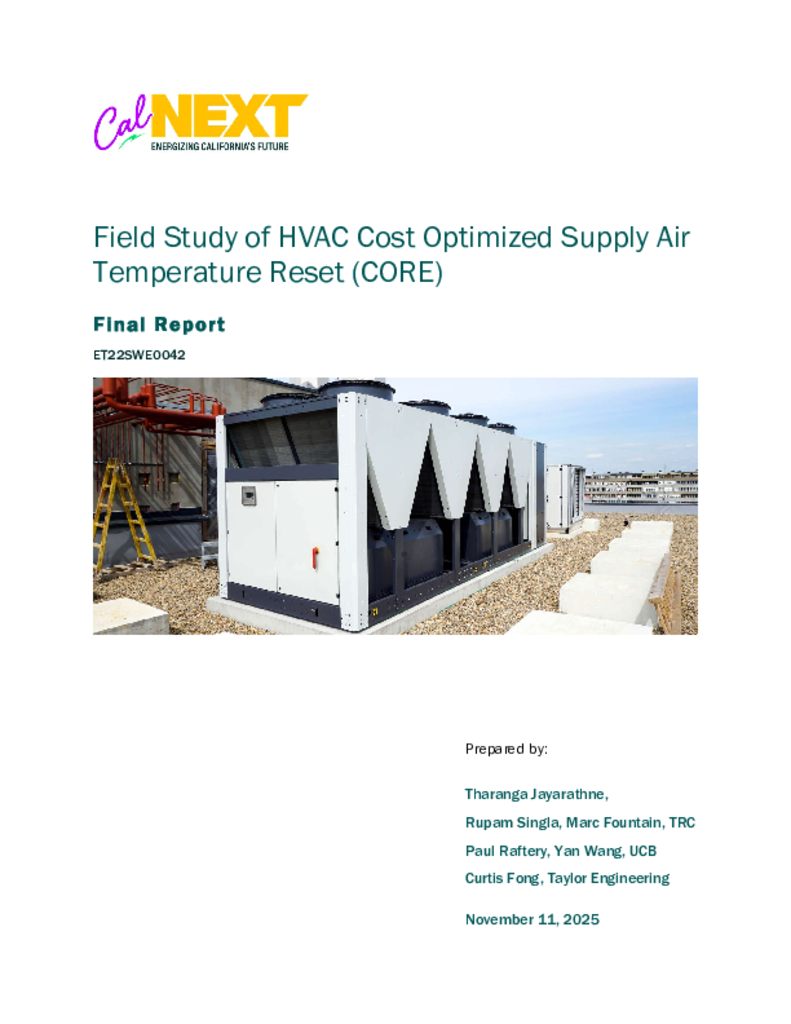ET22SWE0042 - Field Study of HVAC Cost Optimized Supply Air Temperature Reset (CORE)
Variable air volume (VAV) HVAC systems dominate the commercial building market but have widely varying performance, with a well-documented performance gap between best-practice and typical operation. Two recent studies by Lawrence Berkeley National Lab and the California Energy Commission (CEC) reported a wide variation in energy performance for various typical supply air temperature (SAT) reset strategies (4-15% variation in HVAC energy). Existing SAT reset strategies have three inherent deficiencies that explain the lack of market uptake and sub-optimal real world energy performance: (1) they include simplifications and assumptions about SAT and total HVAC energy cost, (2) they require tuning of key parameters whose optimal values differ for every building and vary over the life of the building, and (3) there is no easy way to determine what those optimal settings are and whether tuning is improving savings or not. CORE (Cost Optimized Reset), a new cost-responsive supply air temperature reset open-source solution for multi-zone variable air volume systems, addresses these problems. This solution applies to the majority of the time that a building is occupied. In a VAV reheat system (the focus of this study), the air handler provides cooling most of the time, with zones providing heating where-needed. The open-source SAT reset solution developed by this research team could be deployed through two different paths: 1) the traditional path of a native building automation system (BAS) and 2) a third-party solution such as a microcontroller or a cloud based solution that integrates with an existing BAS. CORE dynamically estimates the energy cost of operating an air handling unit at its current supply air temperature setpoint, as well as slightly higher and lower setpoints. It does this using existing instrumentation commonplace in these systems. Using this information, along with the current approximate cost of electricity, chilled water, and hot water, we can dynamically estimate the cost of fan, cooling, and reheat energy at each setpoint. The algorithm then chooses the lowest cost operating point every 5 minutes, continually moving in the direction of least cost while adjusting to the changes occurring dynamically within the building, while ensuring that comfort conditions are maintained. CORE offers greater value over existing solutions because: (a) it uses existing sensors and hardware typically installed in modern VAV systems, (b) in contrast to far more complex model predictive control solutions, it is simple enough to be implemented either within the existing building automation system’s logic, or in an independent controller, and (c) it adjusts automatically to operational or weather-related changes in the building over time to directly minimize energy cost. CORE offers benefit to building owners, building operators (who will see improved occupant comfort and will spend less time and money troubleshooting), BAS manufacturers, third-party vendors, and other stakeholders. In this project, the research team will implement CORE at multiple test sites and determine energy savings.
This project demonstrates the development and deployment of Cost Optimized Reset (CORE), a dynamic, cost-responsive supply air temperature reset strategy designed to minimize heating, cooling, and fan energy use in multi-zone variable air volume (VAV) heating, ventilation, and air-conditioning (HVAC) systems. With HVAC energy consumption varying significantly across supply air temperature reset strategies, Cost Optimized Reset offers a solution that optimizes energy use and cost efficiency. The project refined the algorithm for broader adoption in California commercial buildings and evaluated its performance in real-world applications.
The research team implemented CORE in four medical office buildings in California and collected and analyzed HVAC energy consumption data. Measurement and verification analysis compared the new strategy to baseline supply air temperature controls, revealing 5 to 22 percent energy savings and 1 to 20 percent cost savings. Energy simulations further demonstrated that CORE could achieve 1 to 30 percent energy savings in buildings with typical loads and airflows, with simplified versions of the algorithm achieving comparable performance, making it accessible to a wider range of buildings.
Key advancements to CORE included adding smoothing factors for operational stability, updating calculations to accommodate diverse HVAC systems, and creating versions of the algorithm that function with partial or no zone-level data. The study also emphasized the importance of thorough system evaluations and retro-commissioning to address pre-existing issues, ensuring effective implementation of advanced controls. Additionally, the team recommended integrating CORE into programming libraries offered by building automation system manufacturers to streamline deployment and improve compatibility with other controls.
This project highlights the potential of Cost Optimized Reset to enhance energy efficiency and cost savings in commercial buildings, while also identifying pathways for broader adoption and implementation.

